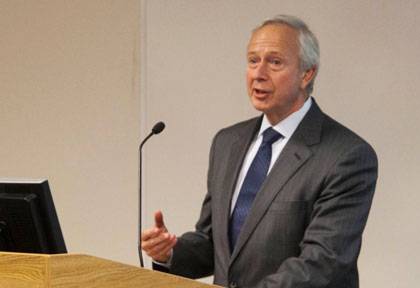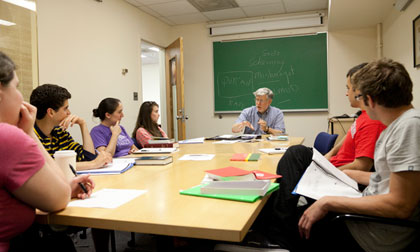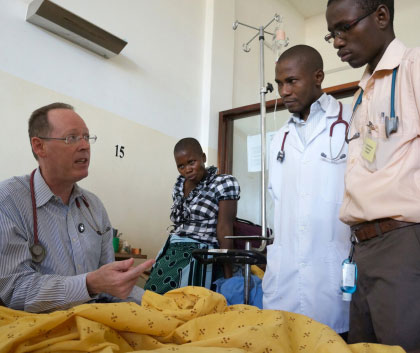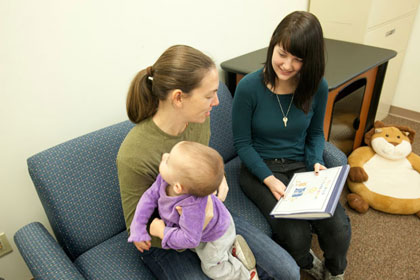Rebuilding the Public's Confidence in Higher Ed
President Brodhead discusses a vision of education to meet the needs of a questioning public

You can scarcely open a newspaper or financial journal these days without finding headlines like "Higher Education: Not What It Used To Be" or "Is College Worth It? 57% of Americans Say Nope." Higher education has always come in for its share of criticism, but the current discourse represents something new. It suggests that we have entered a credit crisis for colleges and universities, a crisis not just in funding but in fundamental credence: a breakdown of the public's confidence that higher education has self-evident value. I want to speak to this crisis, its causes, and its meaning for Duke.
As I read it, the current litany of negativism has four interwoven strands. The first is a cost complaint: college and university prices are already exorbitant and rising unsustainably. The second is a learning complaint. Richard Arum and Josipa Roksa's 2011 book Academically Adrift documented what the authors call "a pattern of limited learning" on American campuses, and journalists have rushed to repeat the news that students make little or no cognitive progress during their college years.
The third might be called a complaint of dashed hopes. In the speeches given at political conventions last summer, the most powerful moment came when Paul Ryan spoke of college grads moving back home to their childhood bedrooms, "staring up at fading Obama posters and wondering when they could move out and get going with life." The New York Times chose as last May's commencement feature a young woman who had finished a four-year private university in Ohio $120,000 in debt, requiring more than $800 in monthly payments which she was working two restaurant jobs to repay. In these iconic images, people believed in college as the road to a productive, secure future, but it took their money and did not deliver.
This implicit scam allegation gives rise to the fourth strain, a complaint of evidence withheld: colleges and universities do not adequately assess whether they are fulfilling their promise to educate, so there is no way for the public to know if they deliver value for price. In Virginia, the call to document education results has produced a law requiring all public and private colleges and universities to post the incomes of their students one year after graduation broken down by college major, so the public can know what course led to what result. Such thinking is one of the few current areas of bipartisan agreement. In the January 2013 State of the Union Address, President Obama promised to "release a new 'College Scorecard' that parents and students can use to compare schools based on a simple criteria: where you can get the most bang for your educational buck."

At a place like Duke, it is far too easy to dismiss this chorus of complaint as the newest form of anti-intellectualism. But this consensus is a powerful new feature of the terrain we must navigate, and it has its share of truth. The cost of higher education has risen well above inflation or family earnings increases for many years, outstripping even the rising cost of health care. Since the recession, student loans have risen dramatically even as credit card and mortgage debt has declined. Meanwhile, large numbers of students fail to complete a college degree after enrolling, incurring the cost without winning the reward. Given all this, it does not seem unreasonable to ask: in such a costly, risky transaction, shouldn't the consumer be able to know what value they will get for their money?
So far, this logic appears unassailable, but these oft-repeated claims can convey profound misunderstandings. Costs have indeed risen, but not only through the academy's doings. The share of state support for public higher education has been declining for many years (remember, 73% of college students attend public institutions); since 2008 alone, state support for higher education has fallen 25% in real terms. Partly due to revenue shortfalls since the recession, partly to growing distrust of big government, the cost of college has been shifted steadily from the state to students and families, and the sense has gained ground that education is a benefit for the individual, a private good, not -- as was long believed -- a long-term social gain worthy of public investment.
Further, skeptical accounts of the value of education often fail to mention well-established facts that would correct the picture. College completion does strongly correlate with higher income in later life. Analysis of the 2010 census estimates the earnings of a bachelor's degree holder over his or her worklife at $2.4 million compared to just $1.4 million for a high school graduate -- a million dollar difference. And if not every graduate finds the job of his or her dreams, college completion is highly correlated with employment prospects. In 2012, the unemployment rate for workers over twenty-five was 8.3% for those with a high school diploma and 7.7% for those with some college but no degree, but only 4.5% for college graduates. Research by the Mobility Project of the Pew Charitable Trusts found that in the wake of the 2008 economic downturn, the employment rate among 21- to 24-year olds dropped 8 percentage points for high school graduates and 7 points for those with associate's degrees but only 4 points for those with bachelor's degrees.
Is college worth the money? You reach the negative answer a lot quicker when this part of the story goes unreported.
It is also crucial to remember that American higher education has many quite distinct sectors, and that a generalization that works for the whole can be quite misleading when applied to a part. The percent of borrowers who do not graduate is significantly higher in for-profit institutions and is lowest in four-year, not-for-profit schools, public and private. And there are significant differences even within this zone. I found it instructive to go to the White House website the morning after the State of the Union Address. Duke's scorecard had indeed been posted. What it showed was that Duke's net price was high (no surprise there); but that the net price had decreased from 2007 to 2009; that 94.4% of students graduated within six years; and that net indebtedness and amount of monthly debt payment were quite low, with virtually no graduates defaulting on loans.
You know what explains this scorecard. Within the set of private four-year colleges and universities, Duke belongs to the subset that is highly selective, charges high tuition for an extraordinarily rich experience, but then mitigates the cost through extensive financial aid. Even adjusted for inflation, cost of attendance has risen steadily here (less steeply in recent years), as we have continued to invest in deepening educational opportunities. But under Duke's policies of need-blind admissions, the share of costs that a student's family cannot afford is covered by institutional aid, which has risen at a far higher rate than tuition. In constant dollars, when corrected by aid, the cost of attending Duke has actually fallen for families with financial need both in absolute terms and as a percent of family income, and cumulative debt has remained flat as well.
You begin to see the problem. The measures of value that do usefully show whether some kinds of schools give the hoped-for bang for the educational buck -- graduation rates, debt rates, incomes after graduation -- are unrevealing when applied to a school like Duke. At the same time, these measures do almost nothing to assess the true value of a Duke education, which must be reckoned in very different terms.
The heart of Duke's value proposition is that we offer a liberal arts education. This is not just a matter of requiring students to visit random unrelated subject fields and check the curricular boxes. Beyond its formal requirements, this education aims to engage multiple forms of intelligence to create deep and enduring habits of mind, an active, integrative, versatile spirit naturally disposed, when it comes upon a new fact or situation, to go to work trying to understand it, updating preexisting understandings in this new light.
The value of this habit of mind is not to be measured by income alone, least of all income one year after graduation. It is, in the fullest sense, equipment for living. Its value is that it supplies enrichment to personal lives, equips students to be thoughtful and constructive social contributors, and enables them to participate fully and creatively in the dynamic, ever-changing world that awaits them when they graduate.
This kind of education is difficult to measure, and it's not just financial metrics that get it wrong. Tools for assessing learning outcomes are often ill designed to capture the distinctive benefits of such an education. Learning outcomes are commonly measured by isolating goals and testing each separately, but the essence of liberal arts education is that it integrates forms of knowledge, builds them together in a complex, evolving mind. So too learning outcomes are often assessed at the point of exit, but the powers the liberal arts develop continue to deepen in use, revealing their full value over the course of a long, productive life.

Plus learning outcomes typically measure academic inputs and outputs as if those captured the whole of education, while at a school like Duke, all manner of engagements work together as agents of discovery. Paul Farmer, one of the world's most admired medical humanitarians and a powerful innovator in health care for the developing world, went to Duke planning to major in the sciences, an excellent start for a future doctor. But as Tracy Kidder chronicles in Mountains Beyond Mountains, Farmer was also his fraternity's social chair, had his mind opened to the social determinants of medicine in an anthropology class, and got to know Haitian farm workers on a Duke volunteer service project in rural North Carolina. Few of these would show up on a documented chart of assessed learning, but all of them -- interacting with one another in unpredictable, unprogrammed ways -- helped create the Paul Farmer the world knows.
This poor fit between the metrics advocated in contemporary debates and our actual goals explains why schools in our sector have been skeptical towards the assessment movement. The best statement I know of the case was delivered by Christopher Eisgruber, provost of Princeton, at the Association of American Universities last April. Citing learning studies that show that the single factor most highly correlated with substantial mental gains is the student's active engagement in his or her education, Eisgruber argues that it is far more valuable for colleges to invest in building a culture of engagement than a culture tightly focused on assessment.
I have considerable sympathy with this view, but we are naive if we think we can duck the current push for accountability without doing more to confront it. The slogan "We have a value you are apparently unable to understand" is not a winner in the contest for public opinion, and though there are many who want and "get" what we have on offer, higher education needs far broader public support than that. In face of the current academic credit crisis, we need to do all we can to validate and publicize the learning that takes place here -- and stay mindful of the value that can be measured and the equally real value that cannot.
We have access to measures that are significant in this context from our periodic surveys of graduates and parents of students. In the 2012 study, 94% of Duke parents reported themselves very or generally satisfied with their child's undergraduate education, with those "very satisfied" rising from 50% to 60% between 2007 and 2012. Asked to rate the most important element in undergraduate education, 88% of Duke parents listed "promote broad-based education that promotes personal growth" -- suggesting a high convergence between this university's idea of its value and what is valued by those who pay the bills.
Every five years, Duke does a survey of alumni who are five years post-graduation, ten years out, and twenty years out. These are of interest because they show people assessing the value of their education when they have been out long enough to fully experience that value. Our most recent numbers come from the 2009 survey conducted on the classes of 2004, 1999, and 1989. Asked "overall, how satisfied are you with your undergraduate education," roughly 92% reported being very or generally satisfied. When asked "how you would change the emphasis Duke puts on liberal arts education," alumni overwhelmingly said that they would maintain or increase this emphasis. Asked what the university should place more priority on, the alumni highlighted faculty-student contact outside class, leadership, workplace skills, undergraduate teaching, public service, and global awareness. Blending long-term and short-term elements like workplace skills will always be a challenge at schools like Duke. But what is otherwise striking about this list is that what graduates want more of are the very things we want them to want. They want more engagement with their formal education, more contact with their teachers, and more preparation to be broadly effective in the world -- in effect, yet more benefits of liberal arts education.

Duke has taken extraordinary pains to fulfill these aspirations in recent years. The number of undergraduates participating in faculty-mentored research has risen from 15% in 2002 to 50% in recent classes. The number of students doing a senior honors thesis has more than doubled in that time. Since the classes who were polled graduated, the call for more emphasis on leadership, public service and global awareness has been met by the creation of programs like Duke Engage, Global Health, the Winter Forum, and the Engineering Grand Challenges. All of our recent innovations give students deepened relations with teachers beyond their formal roles in the classroom, so the faculty-student contact number is certain to climb.
We need to continue to monitor Duke undergraduate education to make sure that the dreams we have for our students come true in their experience. I have argued against short-term, mechanistic measures, but it will be worth our while to keep striving to learn what can be measured, and how those results can help us continue to improve. I'm grateful to Vice Provost Keith Whitfield and the many who are working with him to devise assessment tools better fitted to this school's goals. This is an important priority.
That said, I trust my message is clear. There is no point pretending to assess the value of an education without first trying to understand what the value of education actually consists of. This will and should be different at different kinds of schools: education is not one thing. But just for that reason, we need to avoid measuring it in one way.
Let me close with two final words on liberal arts values, one addressed to this university, the other to the larger world.
The figures I've shared give reason to be proud of the work we've done at Duke. But self-satisfaction is the chief danger besetting our education sector. Though we are comfortable within our walls, with twice as many applications as we had ten years back and with heartening alumni support for the Duke Forward campaign, nationally, liberal arts education is beset with adversaries: a public scornful of its short-term returns, and online rivals that threaten to disrupt familiar models, to name but two.
Before such challenges, we need to take absolute care that we deliver the thing we claim to supply. The faculty has a crucial role in this proposition. Since the faculty presides over the curriculum, the faculty must take responsibility for assessing our offerings in the light of high liberal arts ideals. Courses narrowly tied to academic specializations can be extraordinarily valuable to students at a great research university, letting them experience first-hand the living work of discovery. But we need to ensure that the curriculum also offers the broad-gauged, integrative courses on which liberal education can be grounded.
Further, every study shows that if limited learning takes place at many American colleges and universities, far more takes place at highly selective institutions, where it is keyed to certain reliable constants: high faculty expectations, demanding requirements for reading and writing, and high degrees of personal interaction between faculty and students. It is only the faculty that can deliver this good, through your rigor and your generosity with your attention.
As online instruction supplies a more and more valuable supplement to traditional educational delivery, the part it cannot replace will become more precious: learning face to face, the community of whole, living people interacting with each other in a thousand daily forms. My hope is that Duke will be a pioneer in creating the best blend of online and face-to-face education. For us to accomplish this, it must be the work of every faculty member to be imaginative with their teaching formats and available for the encounters that transform lives.
If the faculty has a crucial role in delivering liberal arts value, so too does advising. The glory of a curriculum like ours is that it provides ample room for exploration and discovery; at a school like Duke, the extra-curriculum is also profoundly educational and comparably rich. The downside of such a school is that students face almost infinite choices without always having an adequate sense of how choices could most valuably be pieced together. Meanwhile, many advising duties fall to faculty who, with the best will in the world, can't possibly know everything about the smorgasbord of curricular, co-curricular and extra-curricular opportunities that besiege the students they advise. Building on the existing system and benefitting from new experiments like the global advisor program, Duke needs to create a new version of advising that will be comprehensively mindful of available opportunities and help students take optimal advantage as they build an education. I am grateful that Arts and Sciences Dean Laurie Patton, Dean and Vice Provost for Undergraduate Education Steve Nowicki, and Dean of Academic Affairs Lee Baker are deep in discussion of this matter.
Finally, a word outside our walls. I am highly mindful that the conditions that allow our version of education to thrive are not broadly shared: a sizeable endowment, a generous donor base, a well-equipped campus, excruciatingly high admissions selectivity. Many want and need higher education beyond the number who can be accommodated at a place like Duke. Many are legitimately interested in training that will pay off in the shorter term. Many institutions serve students with nothing like the resource base we take for granted.
Duke's facts are not everyone's facts, and Duke's solutions cannot be everyone's solutions. But I still maintain that liberal arts education is a broader public need than the American public shows any sign of recognizing. At heart, liberal arts education is not about a particular set of courses. It is about building broadly capable people who can live up to their personal potential and fill all the roles a complex, changing world will require. Such training should not be the exclusive birthright of the wealthy or those with high SATs. This is a fundamental social need, and for the future health of our society, such benefits need to be spread far more widely than they are today.
The Commission on Humanities and the Social Sciences that the American Academy of Arts and Sciences asked me to co-chair has become, de facto, a commission for advancing the liberal arts. The commission is well stocked with scholars and university presidents, but many of the most eloquent voices come from non-academics and those outside elite institutions. James McNerney, the CEO of Boeing, has told us that high-tech manufacturing requires engineers but that beyond a certain level, a person will not advance unless he or she has a broader array of skills, especially skills at verbal communication and interacting with culturally diverse others -- liberal arts training par excellence. General and Ambassador Karl Eikenberry, who headed military and then diplomatic efforts in Afghanistan, has testified that in the globalized modern world, weapons can only do so much to protect national security. Equally essential are the understanding of foreign languages, foreign histories and cultures, and beliefs and ethical systems different from our own: classic products of liberal arts education.
Norm Augustine, longtime head of Lockheed Martin and the principal force behind the National Academies' report Rising Above the Gathering Storm, has been one of the country's most effective advocates for strengthening STEM education. But he has never argued that STEM by itself made an adequate preparation. Gathering evidence, weighing interpretations, and making arguments are core skills for creative workers and good citizens, and these are all developed through broad training across the arts and sciences. Augustine has said that the greatest single deficiency in American education is in the teaching of history.
Eduardo Padron, President of Miami Dade College, reminded us that one-third of the undergraduates in the United States are in community colleges, where their aims are not exclusively technical. Miami Dade serves 175,000 students, 90% minority, more than 60% low income, many of them immigrants or first generation -- as Padron said, "we take the people who can't pay or be admitted elsewhere." But even when these students seek training for a particular job, it's the broader training they receive that helps them to the next job. Padron is himself an example of the civic benefit we all derive from a broadening education that is not an elite one. This immigrant youth got his first taste of economics as a community college student, starting him on the road to a PhD in Economics and life as a major leader in public higher education.
I conclude with this. The value of higher education has been put in question in recent years as it rarely has been before. This is not a bad thing. Many legitimate questions are being asked, the status quo is very far from ideal -- and since higher education today is assuredly creating the future we will live with tomorrow, this is a matter of the most critical importance. Our problem is not that we are having the value discussion, but that a narrow, impoverished concept of value has been driving the value discussion.
To build the system that will give us greatest benefit as a society, we need to start from a rich concept of what education is good for, one that ranges from the most practical to the most aspirational human registers and from the shortest-term to the longest-term goals. Working from such a concept, we could then discuss how the best version of education could be delivered within the facts and resources of different situations, providing the most value for the money at hand.
You and I have work to do making Duke live up to our ambitions. But we also have work to do voicing a fuller vision of education to a culture where such voices are currently little heard. Nowadays, part of the work of educators is working to remind ourselves and others what, in the deep sense, education could really be. We have work to do.